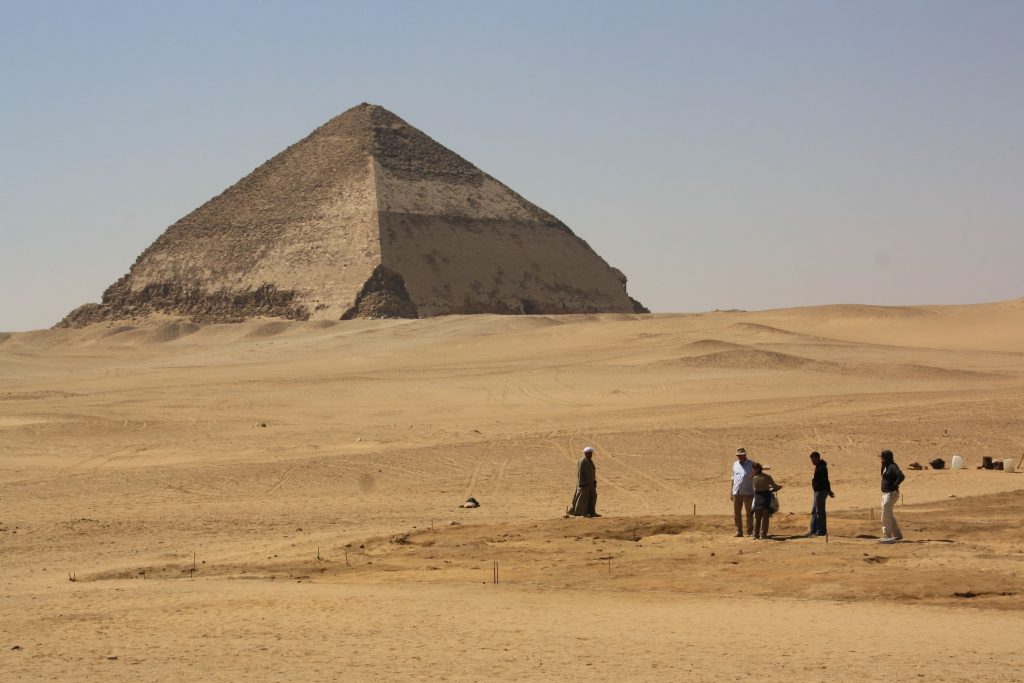The Dahshur Pyramid complex stands as a testament to Egypt’s monumental evolution in pyramid construction during the Old Kingdom era. Nestled within the vast desert south of Cairo, Dahshur marks a pivotal chapter in royal funerary architecture, showcasing bold experiments by Pharaoh Sneferu. From the enigmatic Bent Pyramid to the imposing Red Pyramid, this site represents innovation, ambition, and enduring mystery captivating historians and tourists alike.
The History of the Dahshur Pyramid
Dahshur pyramids were built during Egypt’s Fourth Dynasty, around 2613–2589 BCE, under Pharaoh Sneferu’s reign. He pioneered attempts to perfect the pyramid shape that would culminate in the Giza pyramids. The Bent Pyramid, with its unique change in angle, reveals the early challenges engineers faced. Sneferu’s Red Pyramid, nearby, marks one of the world’s first successful true pyramids with smooth sides. Dahshur thus occupies a crucial role in the architectural timeline, bridging ancient mastaba tombs and grand pyramidal forms.
How Were the Dahshur Pyramids Built?
The construction of Dahshur pyramids involved massive limestone blocks quarried from nearby formations. Workers employed ramps, sledges, and immense manpower to shape and position huge stones with remarkable precision. The Bent Pyramid shows an initial steep angle (54 degrees) that lessened midway (to 43 degrees) to prevent structural collapse, teaching invaluable lessons. The Red Pyramid was built with a uniform slope of about 43 degrees, representing a design breakthrough. Interior chambers and passageways were intricately carved, emphasizing both tomb security and religious symbolism.
Location of Dahshur and Its Surroundings
Dahshur lies approximately 40 kilometers south of Cairo on the west bank of the Nile. It is part of the greater Memphis necropolis region, home to several pyramids and ancient structures. Unlike the busy Giza Plateau, Dahshur offers a quieter, less commercialized glimpse into Old Kingdom Egypt, enhanced by the surrounding desert’s tranquil majesty. Archaeological research continues in the area, yielding fascinating discoveries about Egypt’s royal burial practices.
What Makes the Dahshur Pyramids Unique?
Dahshur pyramids are unique for their architectural experimentation and their role as the birthplace of the smooth-sided pyramid design. The Bent Pyramid’s unusual “bent” shape reflects engineering adaptation, making it one of the only Egyptian pyramids with two different inclinations. The Red Pyramid stands as the first successful smooth-sided pyramid and one of Egypt’s largest, a precursor in its design to the Great Pyramid at Giza. This combination of innovation, preservation, and historical importance sets Dahshur apart as a must-visit archaeological site.
Fascinating Facts About Dahshur Pyramids
- Sneferu is credited with constructing at least three pyramids, including Meidum alongside the Dahshur site.
- The Bent Pyramid is one of only two Egyptian pyramids to retain much of its original polished limestone casing.
- The Red Pyramid contains three burial chambers, one of which features a rare corbelled ceiling technique.
- Dahshur pyramids inspired the construction of later iconic pyramids on the Giza Plateau.
- Excavations have uncovered subsidiary pyramids for queens and royals surrounding the main structures.
Conclusion
The Dahshur Pyramid complex encapsulates a remarkable era of Egyptian history where architectural innovation paved the way for timeless monuments. Its story of trial, error, and triumph continues to fascinate scholars and visitors alike. Exploring Dahshur offers profound insight into the ancient Egyptian quest for immortality and enduring legacy.




